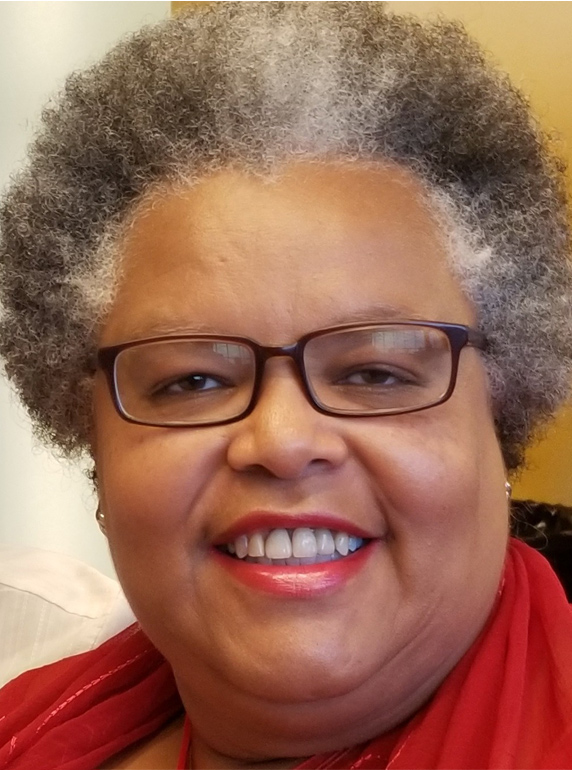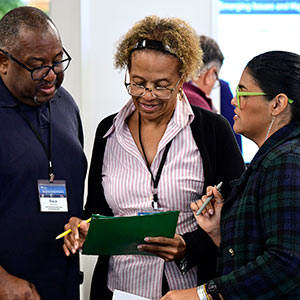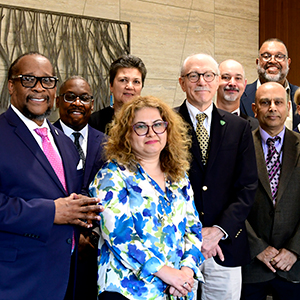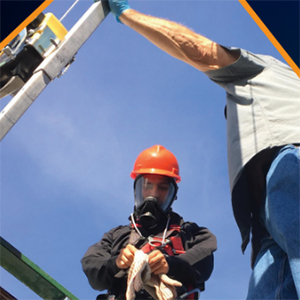 “Although partnerships may take various forms, they all require an understanding of expectations and negotiations that result in mutual benefits,” said Beard. (Photo courtesy of Steve McCaw / NIEHS)
“Although partnerships may take various forms, they all require an understanding of expectations and negotiations that result in mutual benefits,” said Beard. (Photo courtesy of Steve McCaw / NIEHS)During the NIEHS Worker Training Program (WTP) fall 2021 workshop(https://tools.niehs.nih.gov/wetp/events.cfm?id=2619) held Oct. 20-21, participants shared experiences with and strategies for organizational partnerships aimed at improving worker health and safety.
“Building and sustaining partnerships ensures the longevity and success of WTP efforts at a local and national scale,” said Sharon Beard, WTP director.
Community-based organizations, labor groups, and educational institutions provided their perspectives during the meeting.
Setting the stage
The keynote panel highlighted personal experiences involving workplace safety training partnerships.
Mitchel Rosen, Ph.D., director of the Atlantic Center for Occupational Health and Safety Training, moderated the discussion.
“Believe in partnerships,” said Montgomery Proffit, director of pre-employment education and training at OAI, Inc.
“They save time, increase creativity, and expand [our] network,” Proffit added.
Such collaboration helps to fill gaps in services and should be mutually beneficial, according to Janelle Rios, Ph.D., Director of the Prevention, Preparedness, and Response Consortium.
Challenges that come with maintaining meaningful relationships include shifts in leadership, change in organizational focus, and unmet expectations, Rios and Proffit acknowledged.
 It is important to build a partnership with an entire organization, not just one individual, according to Proffit. (Photo courtesy of Montgomery Proffit)
It is important to build a partnership with an entire organization, not just one individual, according to Proffit. (Photo courtesy of Montgomery Proffit)Greater cooperation is key to overcoming such challenges, noted participants.
“The opposite of division is not unity, it’s collaboration,” said Rosen, referencing singer-songwriter Dar Williams.
Benefits of collaboration
Speakers discussed the benefits of various partnerships and how they led to further opportunities.
For example, United Steelworkers Tony Mazzocchi Center trainers and staff collaborated with Paducah Gaseous Diffusion Plant site contractors to build a hazardous waste handling and disposal training program, noted Ashlee Fitch, the center’s director.
The initial program, funded through NIEHS and the U.S. Department of Energy, opened the door to delivering training on other topics, such as respiratory protection.
Best practices
Speakers discussed how lessons learned structured their best practices for partnerships.
Tips for engaging in partnerships were called strategies for co-existing by Lara Maldjian, from the New York Committee for Occupational Safety and Health.
Her strategies, which are based on the committee’s collaboration with the New York City Metropolitan Transit Authority, include setting ground rules for expectations, keeping communication flowing, giving and receiving feedback regularly, and being flexible.
 A partnership between workers and site leadership at the Paducah Gaseous Diffusion Plant resulted in the development and delivery of a course on the handling, storage, and transportation of specific hazardous waste. (Photo courtesy of Ashlee Fitch)
A partnership between workers and site leadership at the Paducah Gaseous Diffusion Plant resulted in the development and delivery of a course on the handling, storage, and transportation of specific hazardous waste. (Photo courtesy of Ashlee Fitch)“Because we are such a training- and advocacy-heavy organization, we need [our] partnerships in order to bring meaning to the work that we do,” Maldjian said.
Disaster preparedness
Participants repeatedly spoke to the need to build partnerships before disasters.
Continual engagement with communities in disaster-prone areas helps anticipate training or outreach needs after a storm or other emergency, according to Kim Dunn, technical training director at the Deep South Center for Environmental Justice (DSCEJ).
“When we are able to better meet the needs in the communities before disaster, then it is easier for us to get into communities after the disaster,” said Dunn.
A main takeaway of the two-day workshop was that partnerships require teamwork, clear and regular communications, compromise, and active engagement.
 Participants learn skills that can protect them during disaster cleanup in a Hazardous Waste Operations and Emergency Response training course in Florida, offered by DSCEJ under the Historically Black Colleges and Universities Consortium. (Photo courtesy of Kim Dunn)
Participants learn skills that can protect them during disaster cleanup in a Hazardous Waste Operations and Emergency Response training course in Florida, offered by DSCEJ under the Historically Black Colleges and Universities Consortium. (Photo courtesy of Kim Dunn)“The [WTP] grantees increasingly are not individual entities,” noted Kenneth Oldfield, principal investigator of the Alabama Fire College Workplace Safety Training. “They are alliances and associations that have come together with common interests in the common good to make the most effective use of resources that are provided.”
(Meredith Hernlund is a research and communication specialist for MDB Inc., a contractor for the NIEHS Division of Extramural Research and Training. Demia Wright is a public health educator in the WTP.)









